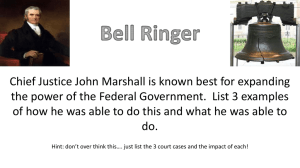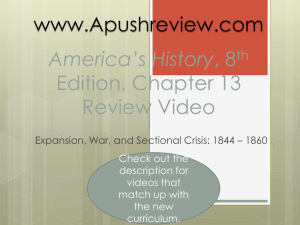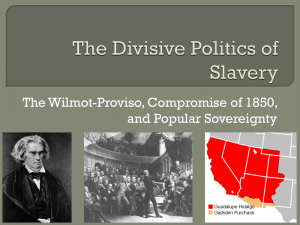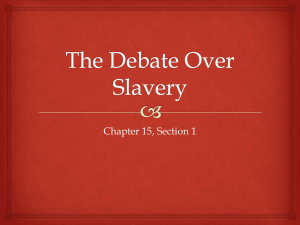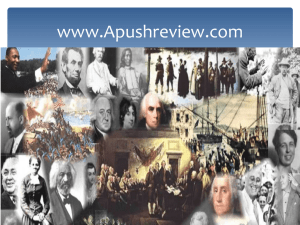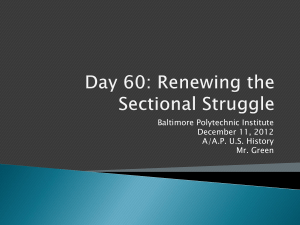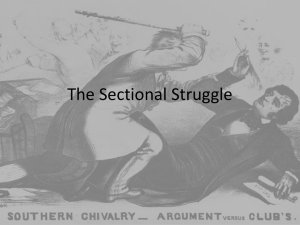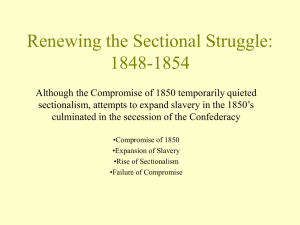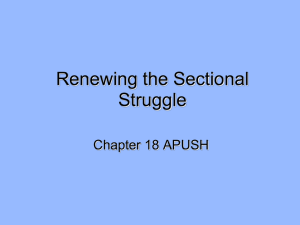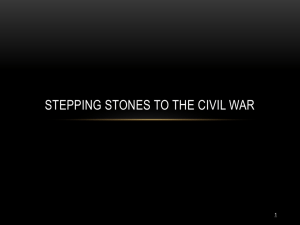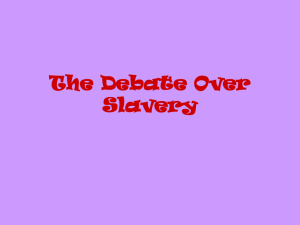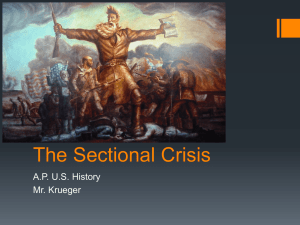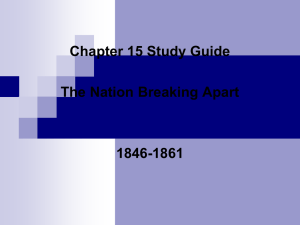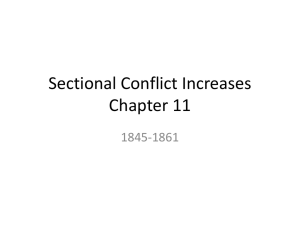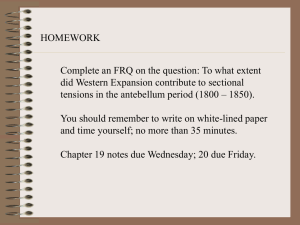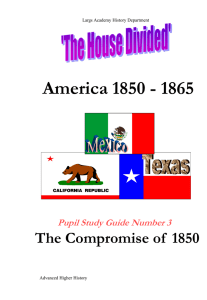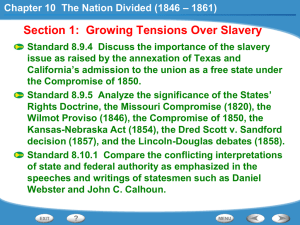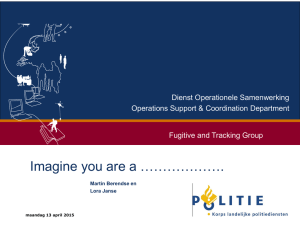File - Miss O`Mallan`s World
advertisement
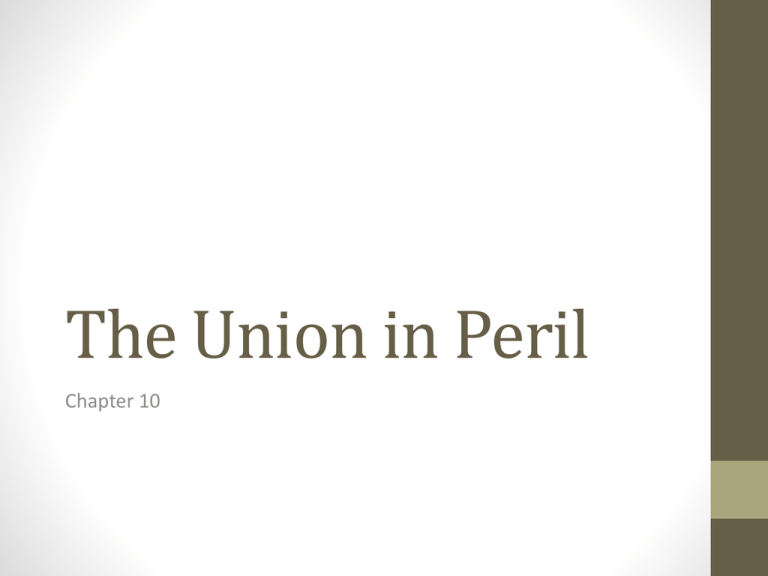
The Union in Peril Chapter 10 Section 1 THE DIVISIVE POLITICS OF SLAVERY Describe the growing differences between the North and South in their economies and ways of life. North • • • • • South Industrial 20,000 miles of RR Factories Large cities Lots of immigrants • • • • • Opposed to slavery • Cotton Gin – 1794 Eli Whitney Agricultural Rural Little industry Few immigrants Differences in North & South North Agriculture Industry Immigration South Northern Cities New York, 1860 Broadway, NY, 1860 Northern Cities Boston, 1860 Boston, 1860 Southern plantations Coolmore Plantation, NC Letitia M. Burwell & William A. McCullough, Illustration Southern plantations Slaves outside plantation cabins Cotton planting and picking Missouri Compromise 1820 Explain why the Wilmot Proviso failed to pass and why the issue of California statehood became so important. • 1846 Congress debated the Wilmot Proviso • Would ban slavery in new territories • North – in favor • South – against • Did not pass Compromise of 1850 Explain why the Wilmot Proviso failed to pass and why the issue of California statehood became so important. • 1849 – CA to enter as free state • South felt should be slave (MO Compromise 1820) • Pres. Taylor – supported CA • Why? • Upset the passionate South • Alarming questions arose Analyze how the efforts of Clay, Webster, and Douglas produced the Compromise of 1850 and a temporary halt to talk of secession. • Henry Clay, Kentucky • Presented Compromise to Congress • • • • North – CA admitted as free South – stricter fugitive laws Popular sovereignty to NM and UT (South liked) Fed. Gov. pay $10 million to TX to release NM (North liked) Analyze how the efforts of Clay, Webster, and Douglas produced the Compromise of 1850 and a temporary halt to talk of secession. • Daniel Webster • Strong supporter of Clay’s compromise • Gave a very convincing speech Analyze how the efforts of Clay, Webster, and Douglas produced the Compromise of 1850 and a temporary halt to talk of secession. • • • • Stephen Douglas, IL Chopped up the bill and passed each separately Taylor dies ~ Fillmore takes over (supportive) Compromise becomes a law Quiz 1 1. The Wilmot Proviso proposed that slavery should be banned from • a. California only. • b. the entire nation. • c. the District of Columbia. • d. all of the territories won from Mexico. Quiz 1 Answer 1. The Wilmot Proviso proposed that slavery should be banned from • a. California only. • b. the entire nation. • c. the District of Columbia. • d. all of the territories won from Mexico. Quiz 2 2. Why were threats of secession feared? • a. People believed they could cause an imbalance in power between the North and the South. • b. People believed that they could result in the abolition of slavery. • c. People believed that they could result in the expansion of slavery. • d. People believed that they could result in the break-up of the Union. Quiz 2 Answer 2. Why were threats of secession feared? • a. People believed they could cause an imbalance in power between the North and the South. • b. People believed that they could result in the abolition of slavery. • c. People believed that they could result in the expansion of slavery. • d. People believed that they could result in the break-up of the Union. Quiz 3 3. Which man did not support the Compromise of 1850? • a. Henry Clay • b. John C. Calhoun • c. Millard Fillmore • d. Stephen A. Douglas Quiz 3 Answer 3. Which man did not support the Compromise of 1850? • a. Henry Clay • b. John C. Calhoun • c. Millard Fillmore • d. Stephen A. Douglas Quiz 4 4. According to the idea of popular sovereignty, which of the following would decide whether slavery would be allowed in a territory? • a. the Senate • b. the President • c. the residents of the territory • d. the House of Representatives Quiz 4 Answer 4. According to the idea of popular sovereignty, which of the following would decide whether slavery would be allowed in a territory? • a. the Senate • b. the President • c. the residents of the territory • d. the House of Representatives Quiz 5 5. Which of the following did not help to save the Compromise of 1850? • a. President Taylor’s death • b. John C. Calhoun’s death • c. its being bundled together as one set of resolutions • d. its being taken apart and presented as separate resolutions Quiz 5 Answer 5. Which of the following did not help to save the Compromise of 1850? • a. President Taylor’s death • b. John C. Calhoun’s death • c. its being bundled together as one set of resolutions • d. its being taken apart and presented as separate resolutions Section 2 PROTEST, RESISTANCE, AND VIOLENCE Describe the provisions of the Fugitive Slave Law and how abolitionists and the Underground Railroad succeeded in defying this law. • Fugitive Slave Act • Alleged fugitive allowed no trial • 6th Amendment? • Not able to testify • Statement from slave owner was all that was required • Federal commissioners given $10 to return, $5 to free • Any aid given was $1,000 fine and/or 6 months in prison Describe the provisions of the Fugitive Slave Law and how abolitionists and the Underground Railroad succeeded in defying this law. • Fugitive Slave Act Fugitive Slave Law of 1850 Fugitive Slave Law of 1850 Underground Railroad Harriet Tubman Underground Railroad
